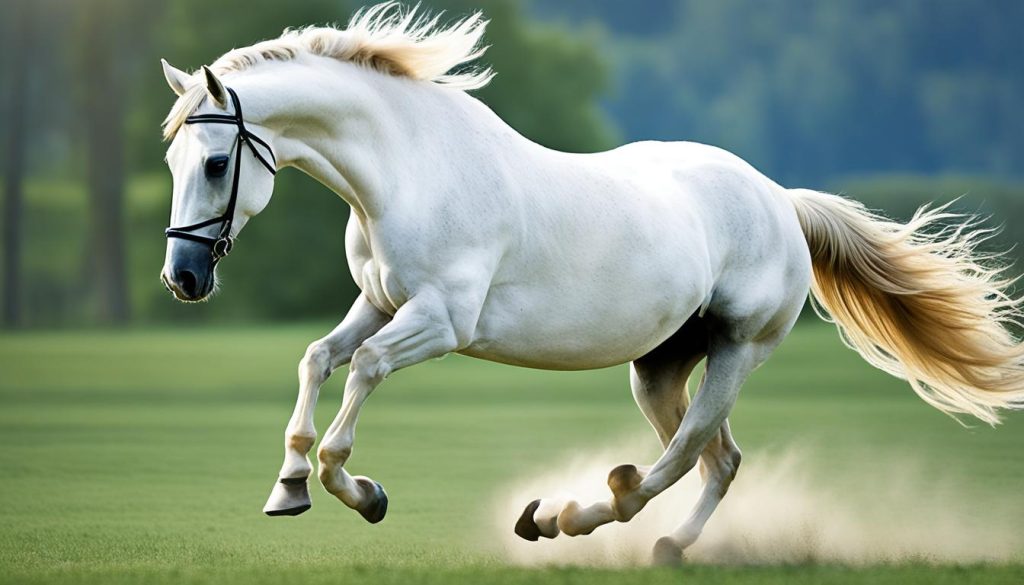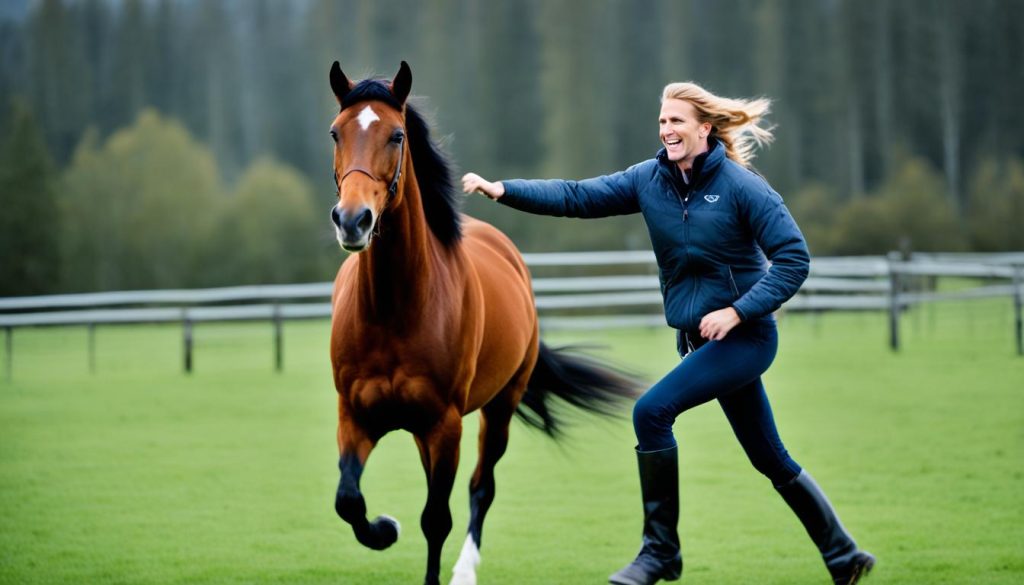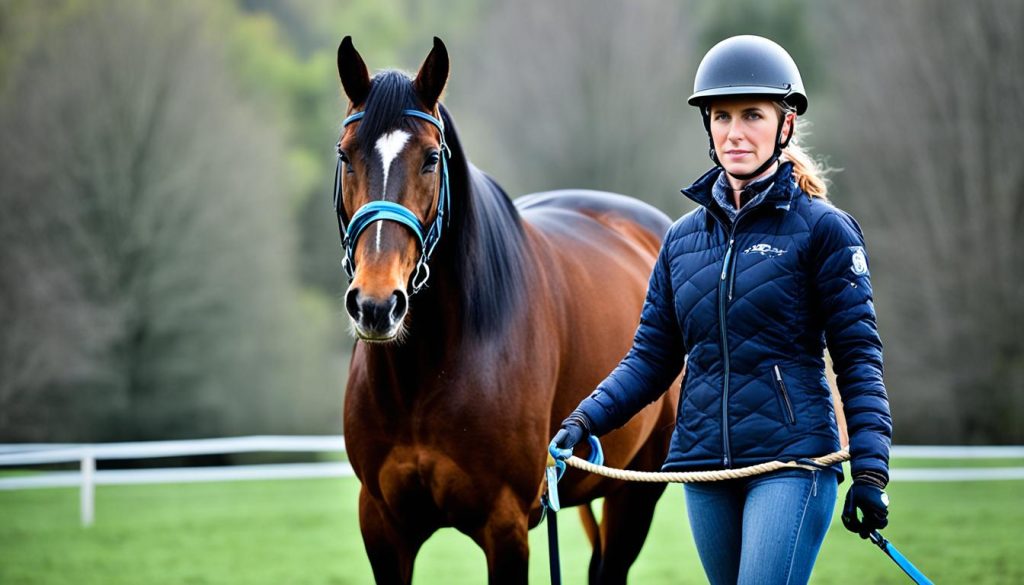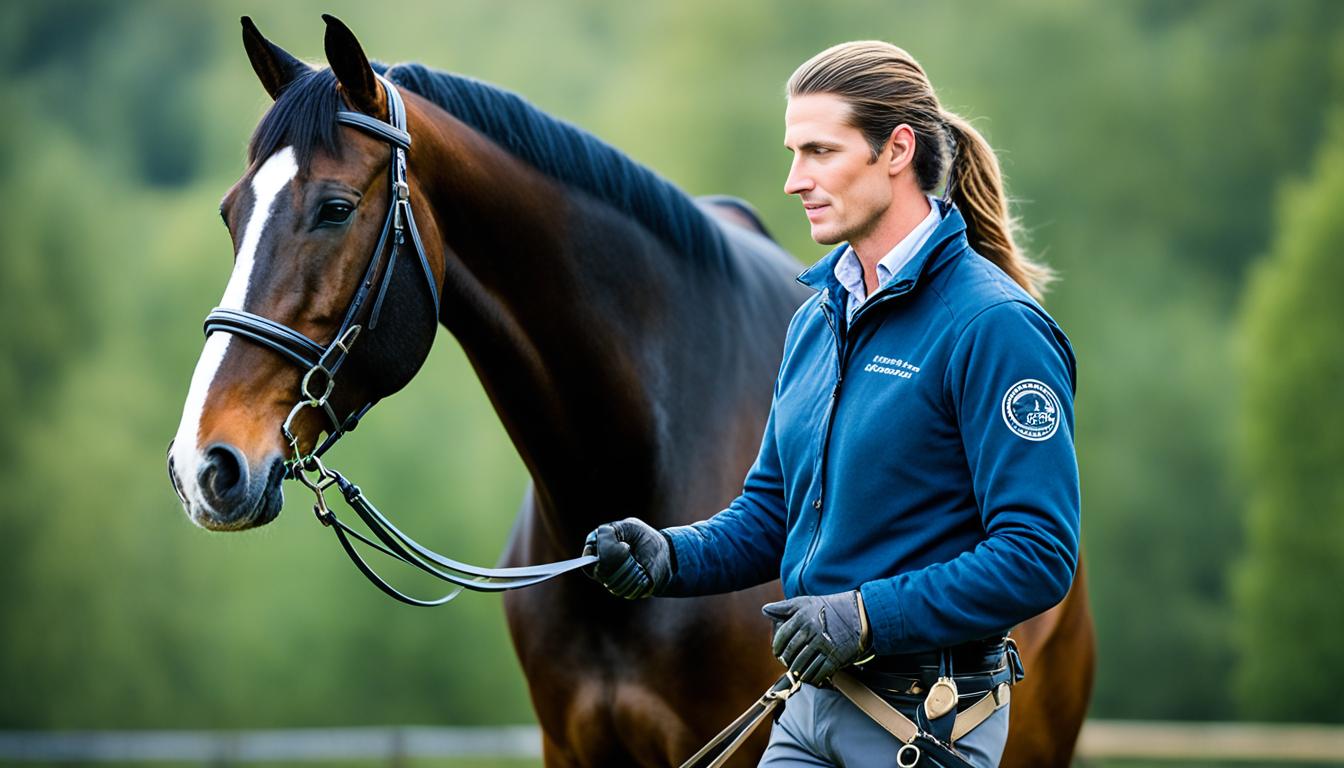“Horses lend us the wings we lack.”
– Pam Brown
Welcome to the world of liberty horse training, where you can unlock a deeper connection with your equine partner and discover the true essence of trust-based horsemanship. Liberty training for horses is a natural and equipment-free approach that allows you to communicate and build a bond with your horse like never before. By embracing the basics of liberty horse training, you can embark on a journey that will elevate your horsemanship skills and transform your relationship with your horse.
Liberty horse training is a powerful method that emphasizes communication, understanding, and cooperation. Through this approach, you can develop a profound bond with your horse and achieve harmony in your interactions. Say goodbye to traditional reins and equipment, and say hello to a new way of connecting with your horse on a deeper level.
Whether you’re a seasoned equestrian or a beginner, liberty horse training offers endless possibilities for growth and learning. It allows you to tap into the innate instincts of the horse and foster a relationship based on trust and mutual respect. By understanding the three modes of liberty training, you can tailor your approach to suit your horse’s needs and your training goals.
Key Takeaways:
- Liberty horse training is a natural and equipment-free approach to horsemanship.
- It emphasizes communication, understanding, and cooperation between the horse and the trainer.
- By embracing the basics of liberty horse training, you can develop a deep bond with your horse.
- There are three modes of liberty training: foundation liberty, natural liberty training, and purest liberty training.
- Through play and trust-building activities, you can deepen your connection with your horse and enhance your partnership.
The Three Modes of Liberty Training
When it comes to liberty horse training, there are three modes that trainers can employ: foundation liberty, natural liberty training, and purest liberty training. Each mode offers unique approaches to building trust and developing a strong bond with your horse.
Foundation Liberty
Foundation liberty focuses on teaching your horse the basic skills necessary to move freely, transition smoothly between gaits, and even carry a saddle. Through this mode of training, you’ll establish a solid foundation of communication and trust with your horse, setting the stage for advanced liberty training techniques.
In foundation liberty training, you’ll use a combination of voice cues, body language, and positive reinforcement to guide your horse and reinforce desired behaviors. This mode of training gradually introduces your horse to the concept of freedom and allows them to build confidence in their movements.
Natural Liberty Training
Natural liberty training takes a step further by involving the use of a rope and halter while maintaining a focus on minimal equipment. This mode allows you to guide and educate your horse while gradually reducing the reliance on tools.
During natural liberty training, you’ll work on refining your communication with your horse, using subtle cues and body language to guide their movements. This approach helps establish a deeper level of trust as your horse becomes more responsive to your signals and begins to rely more on your guidance than physical constraints.
Purest Liberty Training
In the purest form of liberty training, you’ll aim to create a deep connection and prioritize the bond between you and your horse above all else. This mode of training is all about developing a strong and trusting partnership without the need for ropes or other training aids.
Your horse will learn to value being connected to you and willingly follow your guidance. The purest liberty training requires a high level of trust, clear communication, and a deep understanding between you and your horse.

Each mode of liberty training offers its own benefits and can be used based on your goals as a trainer and the needs of your horse. Whether you start with foundation liberty and progress to natural liberty, or strive for the purest form of liberty training, the key is to build trust, establish clear communication, and develop a strong bond with your horse.
Deepening the Connection through Play
In liberty horse training, play is an essential part of deepening the connection between the horse and the trainer. Through play, trainers can inspire the spirit and natural curiosity of the horse, while also mastering the concepts of positive reinforcement training. This form of training allows for communication with the horse without the use of reins or other traditional equipment.
By engaging in play and trust-building activities, trainers can foster a strong bond with their horses and create a partnership based on mutual enjoyment and understanding.
“Play is the highest form of research.” – Albert Einstein
Play provides an opportunity for horses to express themselves freely, promoting their physical and mental well-being. It allows trainers to observe the horse’s natural behaviors, preferences, and personality traits, which can then be integrated into the training process.
During play sessions, trainers can utilize various techniques to communicate with the horse and reinforce positive behavior. Voice cues, body language, and reward-based systems can be used to guide the horse’s movements and encourage cooperation.
Benefits of Play in Liberty Horse Training
- Developing a Strong Bond: Playing with your horse builds trust and establishes a deeper connection between you and your equine partner.
- Fostering Communication: Play allows for non-verbal communication and enables trainers to understand the horse’s needs and desires without relying on reins or other equipment.
- Enhancing Problem-Solving Skills: Engaging in play challenges horses to think creatively and make decisions, which can lead to enhanced problem-solving abilities both in and out of training sessions.
- Promoting Confidence: Through play, horses become more confident in their abilities, leading to increased self-assurance and a willingness to try new things.
Including regular play sessions in your liberty horse training routine not only strengthens the bond between you and your horse but also enriches their overall well-being. Remember to create a safe and stimulating environment to encourage exploration, curiosity, and a sense of enjoyment during playtime.

Building the Foundation for Liberty Horsemanship
To build a solid foundation for liberty horsemanship, it is important to start with the basics. By understanding how to start liberty horsemanship with your horse and building strong communication together, you lay the groundwork for a successful training journey. Building trust with horses and utilizing natural horsemanship methods are key components in this process.
Teaching the Horse to Move Freely
One of the first steps in liberty horse training is teaching the horse to move freely. This involves allowing the horse to explore its surroundings without restrictions or equipment. By giving the horse this freedom, you create an environment that fosters trust and encourages the development of a strong bond between you and your horse.
Changes in Direction and Transition Smoothly
As you progress in your liberty horsemanship journey, it is essential to teach your horse how to change direction and transition smoothly. These skills require effective communication and coordination between you and your horse. By focusing on understanding your horse’s body language and utilizing clear and consistent cues, you can guide your horse with ease and build a stronger connection.
Joining Up with the Trainer
Joining up is an important concept in liberty horsemanship, where the horse voluntarily chooses to follow and cooperate with the trainer. This is a powerful indicator of trust and a significant milestone in building a solid foundation. By utilizing methods such as body language, energy, and positive reinforcement, you can establish a relationship based on mutual understanding and respect.
While the techniques used in foundation liberty can vary, such as voice cues, hand signals, body position, or the use of flags and sticks, the most crucial aspect is the clarity of your outcome as a trainer. Clearly communicating your expectations and establishing trust and understanding between you and your horse will ensure a strong foundation for liberty horsemanship.

Building the foundation for liberty horsemanship is an opportunity to connect with your horse on a deeper level and establish a relationship built on trust and communication. By utilizing natural horsemanship methods and embracing the benefits of liberty horse training, you can create a partnership that allows for a harmonious and enjoyable training experience.
Conclusion
Liberty horse training is a rewarding and effective way to build a deep bond with your horse. By embracing the basics of liberty horsemanship and understanding the three modes of training, you can develop a strong foundation and enhance your communication skills with your horse.
Through play and trust-building activities, you can deepen the connection and create a partnership based on mutual enjoyment and understanding. This natural horsemanship method allows you to develop a strong bond with your horse, ultimately leading to increased trust, improved communication, and a stronger relationship.
So, why not give liberty horse training a try and embark on this journey of building a deep and meaningful connection with your equine partner? Discover the benefits of liberty horse training, develop trust with your horses, apply natural horsemanship methods, and watch as you develop a strong bond with your horse that will transform your equestrian journey.
